There is a way to do it, but it involves a bit of extra work on your part. There is currently no "native" interface in python-docx for doing this. Each bulleted item must be an individual paragraph. Runs apply only to the text characters.
The idea is that list bulleting or numbering is controlled by a concrete bullet or number style, which refers to an abstract style. The abstract style determines the styling of the afflicted paragraph, while the concrete numbering determines the number/bullet within the abstract sequence. This means that you can have paragraphs without bullets and numbering interspersed among the bulleted paragraphs. At the same time, you can restart the numbering/bulleting sequence at any point by creating a new concrete style.
All this information is hashed out (in detail but unsuccessfully) in Issue #25. I don't have the time or resources to lay this to rest right now, but I did write a function that I left in a comment in the discussion thread. This function will look up an abstract style based on the level of indentation and paragraph style you want. It will then create or retrieve a concrete style based on that abstract style and assign it to your paragraph object:
def list_number(doc, par, prev=None, level=None, num=True):
"""
Makes a paragraph into a list item with a specific level and
optional restart.
An attempt will be made to retreive an abstract numbering style that
corresponds to the style of the paragraph. If that is not possible,
the default numbering or bullet style will be used based on the
``num`` parameter.
Parameters
----------
doc : docx.document.Document
The document to add the list into.
par : docx.paragraph.Paragraph
The paragraph to turn into a list item.
prev : docx.paragraph.Paragraph or None
The previous paragraph in the list. If specified, the numbering
and styles will be taken as a continuation of this paragraph.
If omitted, a new numbering scheme will be started.
level : int or None
The level of the paragraph within the outline. If ``prev`` is
set, defaults to the same level as in ``prev``. Otherwise,
defaults to zero.
num : bool
If ``prev`` is :py:obj:`None` and the style of the paragraph
does not correspond to an existing numbering style, this will
determine wether or not the list will be numbered or bulleted.
The result is not guaranteed, but is fairly safe for most Word
templates.
"""
xpath_options = {
True: {'single': 'count(w:lvl)=1 and ', 'level': 0},
False: {'single': '', 'level': level},
}
def style_xpath(prefer_single=True):
"""
The style comes from the outer-scope variable ``par.style.name``.
"""
style = par.style.style_id
return (
'w:abstractNum['
'{single}w:lvl[@w:ilvl="{level}"]/w:pStyle[@w:val="{style}"]'
']/@w:abstractNumId'
).format(style=style, **xpath_options[prefer_single])
def type_xpath(prefer_single=True):
"""
The type is from the outer-scope variable ``num``.
"""
type = 'decimal' if num else 'bullet'
return (
'w:abstractNum['
'{single}w:lvl[@w:ilvl="{level}"]/w:numFmt[@w:val="{type}"]'
']/@w:abstractNumId'
).format(type=type, **xpath_options[prefer_single])
def get_abstract_id():
"""
Select as follows:
1. Match single-level by style (get min ID)
2. Match exact style and level (get min ID)
3. Match single-level decimal/bullet types (get min ID)
4. Match decimal/bullet in requested level (get min ID)
3. 0
"""
for fn in (style_xpath, type_xpath):
for prefer_single in (True, False):
xpath = fn(prefer_single)
ids = numbering.xpath(xpath)
if ids:
return min(int(x) for x in ids)
return 0
if (prev is None or
prev._p.pPr is None or
prev._p.pPr.numPr is None or
prev._p.pPr.numPr.numId is None):
if level is None:
level = 0
numbering = doc.part.numbering_part.numbering_definitions._numbering
# Compute the abstract ID first by style, then by num
anum = get_abstract_id()
# Set the concrete numbering based on the abstract numbering ID
num = numbering.add_num(anum)
# Make sure to override the abstract continuation property
num.add_lvlOverride(ilvl=level).add_startOverride(1)
# Extract the newly-allocated concrete numbering ID
num = num.numId
else:
if level is None:
level = prev._p.pPr.numPr.ilvl.val
# Get the previous concrete numbering ID
num = prev._p.pPr.numPr.numId.val
par._p.get_or_add_pPr().get_or_add_numPr().get_or_add_numId().val = num
par._p.get_or_add_pPr().get_or_add_numPr().get_or_add_ilvl().val = level
Using the styles in the default built-in document stub, you can do something like this:
d = docx.Document()
p0 = d.add_paragraph('Item 1', style='List Bullet')
list_number(d, p0, level=0, num=False)
p1 = d.add_paragraph('Item A', style='List Bullet 2')
list_number(d, p1, p0, level=1)
p2 = d.add_paragraph('Item 2', style='List Bullet')
list_number(d, p2, p1, level=0)
p3 = d.add_paragraph('Item B', style='List Bullet 2')
list_number(d, p3, p2, level=1)
The style will not only affect the tab stops and other display characteristics of the paragraph, but will also help look up the appropriate abstract numbering scheme. When you implicitly set prev=None in the call for p0, the function creates a new concrete numbering scheme. All the remaining paragraphs will inherit the same scheme because they get a prev parameter. The calls to list_number don't have to be interleaved with the calls to add_paragraph like that, as long as the numbering for the paragraph used as prev is set before the call.
You can find an implementation of this function in a library I maintain, called haggis, available on GitHub and PyPi: haggis.files.docx.list_number.

